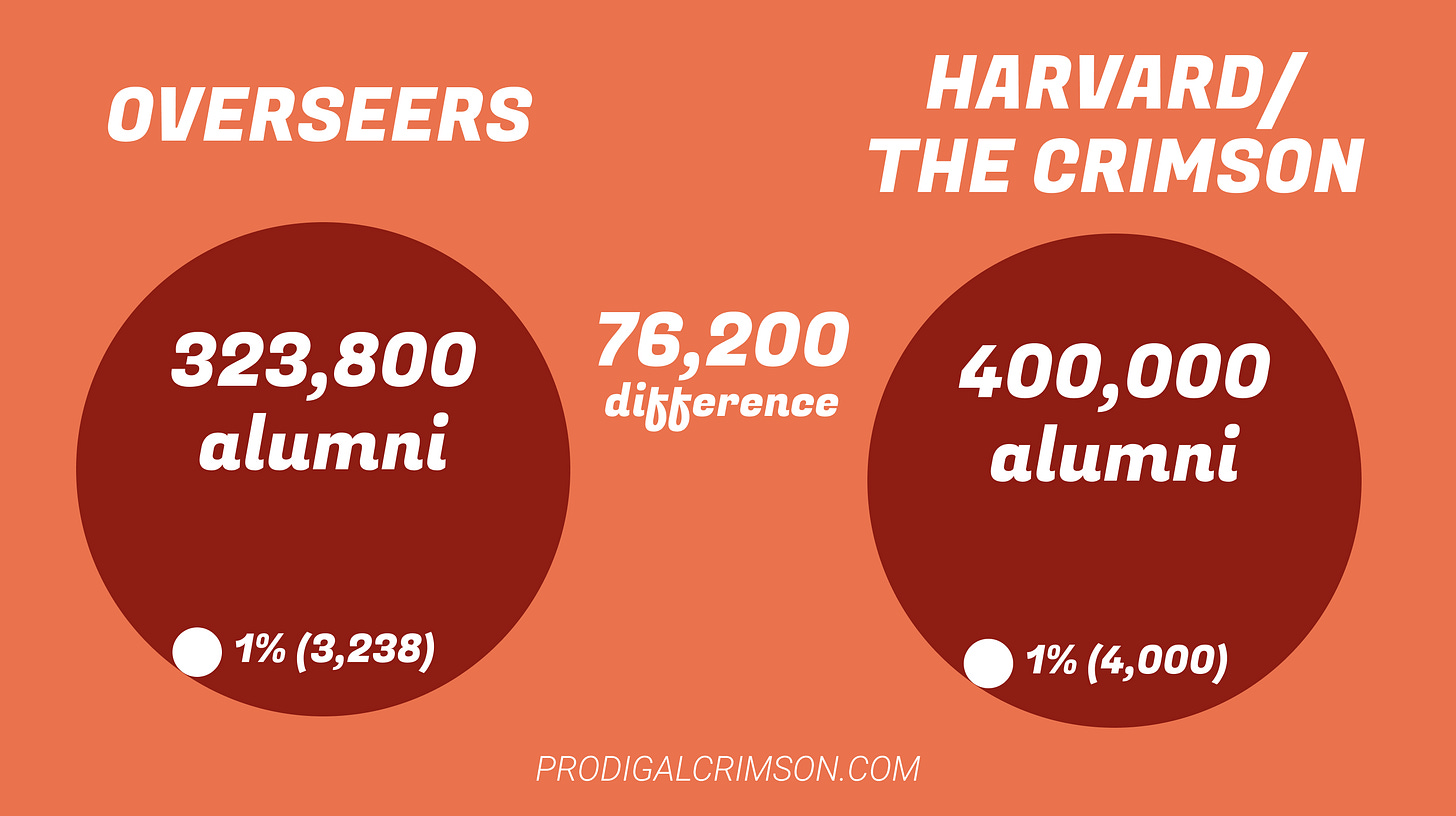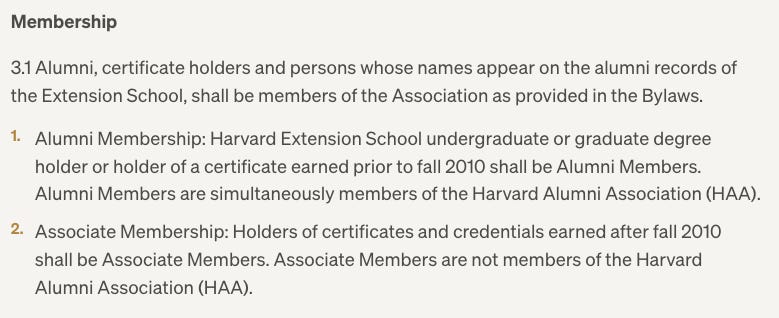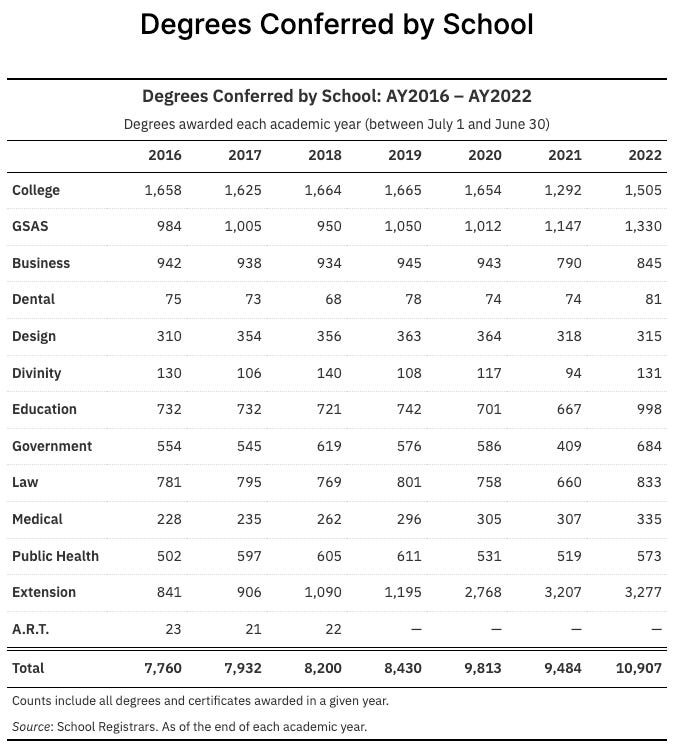Board of Overseers Voting Rates and Numeric Discrepancies
Overseers calculate a smaller alumni pool than Harvard publicly claims, by 76,200!
[Update, February 23: I’ve made promising headway on the numeric discrepancies. Hopefully I’ll have an update soon.]
I was preparing voting rate data for Board of Overseers elections over time, and I noticed something interesting.
The Board of Overseers requires at least 1% of eligible alumni voters to sign a petition to successfully get someone on the Board of Overseers ballot.1 Sam Lessin, a petition candidate, posted an email from Harvard indicating that this election’s 1% threshold was 3,238—this includes all eligible Harvard degree holders as of January 1, 2024.2 This implies an eligible alumni pool of 323,800.
But Harvard itself says it has 400,000+ alumni, which has an implied 1% threshold of 4,000+. And here’s The Harvard Crimson in May 2023 (emphasis added):
Low voter turnout continued to plague the election, with a participation rate of less than 8.11 percent. More than 400,000 Harvard degree-holders were eligible to vote, but just 32,440 ballots were cast in the Overseers election.3
So we have these two competing pictures of the Harvard alumni pool, and therefore of the Board of Overseers petition candidate qualifications. Someone is wrong, or I’m missing something. What could explain the 76,200 qualified alumni difference?
Note: the Overseers number (323,800) is the alumni pool as of January 1, 2024, while the Crimson quote (400,000+) would be referring to the alumni pool as of January 1, 2023. But how could Harvard have lost 76,200 in that time?
Explaining the differential
Qualified electors
First, I thought that maybe some alumni of the 400,000 weren’t qualified to vote in the Overseers elections. But eligible voters for 2024 (emphasis added) “…include all Harvard degree holders whose degrees were received by January 1, 2024, except for members of the Harvard Corporation and officers of government or instruction in the University.”4
There aren’t 76,200 alumni who are disqualified by that, so that’s out.
Extension school students
After a string of reactive, clumsy tweets, Professor Hochschild seems to confirm that Extension School alumni would be able to vote for the Board of Overseers, since they hold Harvard degrees like any other:
I was asked to clarify, and am glad to do so: HES courses are Harvard U courses (often the same as in FAS, as for my courses). HES bachelor’s and master’s degrees are Harvard U degrees. HES is a school in Harvard U analogous to other schools. HES students are Harvard U students —this tweet from January 12, 2024
This makes sense, but the Constitution and Bylaws of the Harvard Extension Alumni Association do distinguish Extension degree holders after 2010 from other alumni—they are not members of the Harvard Alumni Association. Nonetheless, it doesn’t seem like they would account for the 76,200 difference here. The number is still too big.
Someone is just wrong in an interesting way? Is there an edge case?
Maybe there is no good reason for the difference, and someone is just wrong.
Did someone enter a number in an Excel sheet incorrectly, and then never double check it? Or something like that? Stranger things have happened.
Maybe there really is a good explanation for all of this, but it’s an arcane piece of parliamentary procedure that draws different bounds around the pool of eligible alumni. (Seems unlikely, but you never know.)
Cross-referencing against other numbers
A 2016 article from Harvard Magazine says that the 2016 Board of Overseers election had “265,000 currently eligible degree-holders.”5
So as of January 1, 2016,6 we had 265,000 voters, according to Harvard Magazine.
How many voters have we added since then? Thankfully, the Harvard Fact Book can help us out.
Now, this uses academic years (so I might be getting my timelines a little messed up by a semester or so) but it seems like all/most of the degrees on this chart were not included in the 265,000 number, since it would have stopped at January 1, 2016. So if we want to know how many eligible degree holders were added to that number in time for the May 2024 elections, we just add them, plus an estimate for 2023.
That means: 265,000 (the 2016 number from Harvard Magazine) + 62,526 (grand total degrees awarded from the chart above) + 10,000 (estimated 2023 degrees awarded).
That yields: 337,526!
That’s pretty close to the Board of Overseers qualified alumni voting pool of 323,800. I used an estimated number for 2023, and it’s possible I’m missing or double-counting one or two semesters of graduates by starting or stopping my time ranges incorrectly in these calculations.
So this lines up nicely, and it potentially confirms the Board of Overseers numbers; a separate analysis using 298,700 as a January 2021 starting point yields a similar result.7 But I still don’t actually know if it proves anything. It’s only plausible.
I don’t know—do you?
So I’m left with a big question mark. How many eligible alumni voters does Harvard currently have? Why do the Board of Overseers calculate a different number than the 400,000+ figure that’s common elsewhere? What accounts for the difference?
There’s definitely no getting around the fact that the Harvard Crimson article and the Board of Overseers are in direct conflict—one of them is wrong. But that’s a weird number to get wrong. Why is there confusion about it? What other numbers like this are people confused or wrong about?
Anyway, let me know if you think of something I haven’t.
The regular way of getting on the ballot is nomination by the Harvard Alumni Association’s nominating committee.
“Nomination and Election Process,” Harvard Elections. Accessed February 1, 2024.
“Five New Members Elected to Harvard Board of Overseers,” The Harvard Crimson. Accessed February 1, 2024.
“Nomination and Election Process,” Harvard Elections. Accessed February 1, 2024.
“Harvard Reforms Overseer Elections,” Harvard Magazine (September 1, 2016).
I’m using the “by January 1st of the election year” rule going back retroactively, although I’m not exactly sure when January 1 was established as the cutoff. It doesn’t seem like it would impact my numbers a ton if it were shifted +/- a semester.
This article by three petition candidates for the Board of Overseers in January 2021 gives a 1% petition threshold of 2,987, implying an eligible alumni pool of 298,700.




